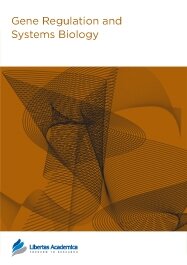

Publication Date: 15 Apr 2009
Type: Original Research
Journal: Gene Regulation and Systems Biology

Motivation: Bi-clustering algorithms aim to identify sets of genes sharing similar expression patterns across a subset of conditions. However direct interpretation or prediction of gene regulatory mechanisms may be difficult as only gene expression data is used. Information about gene regulators may also be available, most commonly about which transcription factors may bind to the promoter region and thus control the expression level of a gene. Thus a method to integrate gene expression and gene regulation information is desirable for clustering and analyzing.
Methods: By incorporating gene regulatory information with gene expression data, we define regulated expression values (REV) as indicators of how a gene is regulated by a specific factor. Existing bi-clustering methods are extended to a three dimensional data space by developing a heuristic TRI-Clustering algorithm. An additional approach named Automatic Boundary Searching algorithm (ABS) is introduced to automatically determine the boundary threshold.
Results: Results based on incorporating ChIP-chip data representing transcription factor-gene interactions show that the algorithms are efficient and robust for detecting tri-clusters. Detailed analysis of the tri-cluster extracted from yeast sporulation REV data shows genes in this cluster exhibited significant differences during the middle and late stages. The implicated regulatory network was then reconstructed for further study of defined regulatory mechanisms. Topological and statistical analysis of this network demonstrated evidence of significant changes of TF activities during the different stages of yeast sporulation, and suggests this approach might be a general way to study regulatory networks undergoing transformations.
PDF (3.01 MB PDF FORMAT)
RIS citation (ENDNOTE, REFERENCE MANAGER, PROCITE, REFWORKS)
BibTex citation (BIBDESK, LATEX)
XML
PMC HTML
Publishing in Gene Regulation and Systems Biology was a very positive experience. I was impressed by the fast and uncomplicated submission process as well as the clear and professional peer review process which helped to improve the manuscript. The Libertas Academica team was very patient and helpful. I would definitely recommend the journal to other colleagues in the field!

All authors are surveyed after their articles are published. Authors are asked to rate their experience in a variety of areas, and their responses help us to monitor our performance. Presented here are their responses in some key areas. No 'poor' or 'very poor' responses were received; these are represented in the 'other' category.See Our Results
Copyright © 2013 Libertas Academica Ltd (except open access articles and accompanying metadata and supplementary files.)
FacebookGoogle+Twitter
PinterestTumblrYouTube